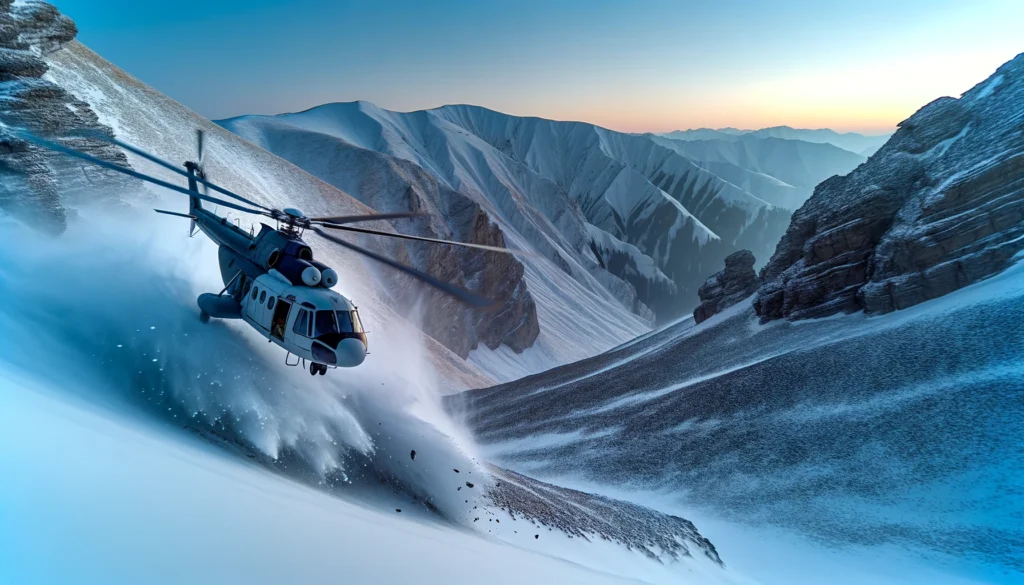Helicopters are a masterpiece of modern engineering that challenges the forces of gravity, by having vertical takeoff capabilities & the possibility to land and fly in midair. Rescuers, military forces, and sightseers can use their exclusive capabilities for all kinds of missions/operations in the sky. However, there is always a question in our mind “How High Can a Helicopter Fly”, but let discuss the basic principles.
Helicopters can so skillfully multitask because they are the versatile workhorses of the skies, embodying a unique blend of engineering and technologically innovative approaches.
The sophisticated life-saving technology in aircraft ranging from small military helicopters to large jetliners is capable of accessing and performing precision tasks even remotely.
Flight to the top of the atmosphere might be prevailing due to the challenges, from the thinning of air to other technical fears.
Secondly, the questions like “How High Can a Helicopter Fly? Can it reach the peak of Mount Everest? can it go beyond the clouds? usually came to our mind, let’s discuss all about it in detail.
This article dives into the exploration of these boundaries, featuring the helicopters that have become the definitions of world records and the beautiful game taking place between human desire and the laws of physics.
Introduction to Helicopter Flight Dynamics
Before talking about altitude limits, it’s essential to comprehend the fundamentals of helicopter flying. Unlike airplanes that only use wings for lift and propulsion, helicopters rely on rotors which make them more flexible because they can ascend vertically, hover, and fly in any direction.
The rotor system, being the main rotor and tail rotor, is the center of helicopter aerodynamics since it generates the lift and controls the direction of movement.
Technological Constraints on “Helicopter” Altitude
- Engine Power and Performance:
The core component of a helicopter consists of the engine. The engine of a helicopter plays a key role in establishing the potential flight height of the aircraft. An abrupt decrease of air density at altitude means engine power loses efficiency and rotor efficiency diminishes the maximum height possible.
- Rotor Efficiency and Blade Design:
Propeller blades are constructed in a way that airlift is maximized from some overlying heights. Despite the thin air, blades will still need to create lift meaning an upgrade will be necessary so that the blades can operate efficiently there. improvements in the blade design (e.g. wider blades, made up of more high-end material), can help to increase the helicopter’s operating altitude.
- Atmospheric Conditions:
Weather and other atmospheric elements are very critical matters that decide the level of safety in which the helicopter can fly. Temperature, air pressure, and wind conditions can interfere with engine power and rotor efficiency, therefore affecting the altitude the helicopter can fly.
The Highest Altitude a “Helicopter” Can Fly To
The most elevated point a helicopter can fly to is referred to as its maximum altitude. Landing of the AS350 B3 on Everest shows off its high altitude capabilities and, of course, the actual highest altitude a Helicopter can go (the service ceiling), depends on the particular model and its flight adaptations for very high altitudes.

In practice, the helicopter is capable of ascending until the air becomes too thin and the rotor blades lose their capacity to generate adequate lift, usually at the levels achieved by the Aerospatiale SA-315B Lama in 1972. In comparison, the altitude operation ceilings for most helicopters are much lower and rarely exceed 20,000 feet (6,096 meters) for standard missions.
Can “Helicopter” Reach the Peak of Mount Everest?
The AS350 B3’s successful landing on Mount Everest symbolizes the capabilities of the helicopters to reach the highest peaks provided the operational conditions are right. Apart from that, this achievement is not only a milestone in aviation history but also enables high-altitude rescue operations and research work. Yet these flights are very complex and demand doing very accurate checks on helicopters and hiring the best-experienced pilots.
Challenges of Landing on Mount Everest
Landing a helicopter on Mount Everest faces a series of challenges:
- Thin Air: As the air gets thinner with altitude, the rotor efficiency and also engine performance get affected, so pilots have to operate the helicopter close to its most powerful flight mode.
- Extreme Weather: Everest weather, being unpredictable and life-threatening, can give up on helicopters, which are prone to winds and quick temperature changes.
- Limited Landing Sites: The steep terrain and uneven nature of the summit make a landing extremely hazardous and require the pilot to perform precise maneuvering.

The Eurocopter AS350 B3 and Mount Everest
One thing that cannot be left unsaid is the Eurocopter AS350 B3 (now Airbus Helicopters H125) that landed at the center of Mount Everest in 2005. This was the first time a helicopter had landed on the top of the mountain at an altitude of about 8,848 meters, which is 29,029 feet.
The mission, handled by Didier Delsalle, demonstrated the helicopter’s higher performance features such as a powerful engine and high-altitude performance, which was considered the latest world record in high-altitude helicopter operation.
Risks of Landing a Helicopter on Mount Everest
The risks involved in landing on Everest are considerable:
- Aerodynamic Stall: Thin air upsurges stall risk on a helicopter where the rotors create lesser lift than to maintain the aircraft airborne.
- Mechanical Stress: The extreme environment places extra strain on the helicopter’s parts, which increases the chance of them failing mechanically.
- Pilot Disorientation: No visual demonstrations and wind-changing quickly in a moment will confuse/disorient pilots which makes the land chance to be more dangerous.
History of Helicopter Rescues on Mount Everest
The airlift operations on Mount Everest have become tremendously prevalent owing to the progression in helicopters and the ability of the crew. As a rule, these operations are usually performed to evacuate climbers to a helicopter, suffering altitude sickness or exhaustion and unable to go down on their own.
The presence of helicopters that can survive in highly extreme environments where people would die without them is very positive although the undertaking of such missions is still always a high risk because of some difficulties.
In 2013, one of the rescues that grabbed everybody’s attention was the extraction of three climbers who were in a camp above 21,000 feet (6,400 meters) by a Eurocopter AS350 B3 helicopter, showcasing the importance of helicopters now craving for rescue operations in the mountains.
The Aerospatiale SA-315B Lama: A Legend in the Heights
On June 21, 1972, the Aerospatiale SA-315B Lama set an altitude record that has remained unbroken, attaining a height of 40,814 feet (12,442 meters) This truly outstanding achievement is due to Jean Boulet, a test pilot whose expertise and bravery made Lama the record holder. Such flight demonstrated the capability for helicopters to fly at very high altitudes but under very specific and precise circumstances.
The Westland Lynx and High-Speed Achievements
Although the Westland Lynx’s speed is not linked directly to altitude, it should be included in the story. In 1986, a modified Lynx set a helicopter speed record of 249.1 miles per hour (400.87 kilometers per hour), thus showcasing the significant engineering advancements that improve helicopter performance in different areas.
The Risks of High-Altitude Helicopter Flights
On the way to the skies, it is not without its risks. The quest to establish and break altitude records has seen its fair share of accidents, which quite well illustrates the dangers associated with taking helicopters beyond the operational limits they are exposed to.
The Perils of Thin Air: Engine Failure and Hypoxia
High-altitude flights might face the problem of engine failure because of the decrease in air density and ultimately this can lead to aviation disaster. Pilots are also exposed to the potential risk of hypoxia, a condition in which the brain functions are negatively affected because of insufficient oxygen levels at high altitudes.
The Ceiling of Helicopter Flight: Theoretical vs. Practical Limits
The maximum permissible altitude of a helicopter differentially differs for different models, named “service ceiling“. On paper, helicopters may continue to arise until the air is thin enough for the rotor blades to produce enough lift.
On the other hand, the limits due to engine power, rotor efficiency, and environmental issues, are the serious obstacles that kept altitudes of usual flights much lower.
The Helicopter’s High-altitude Nemesis: The “Coffin Corner”
Hovering at extremely high altitudes poses a challenge called the “Coffin Corner” among helicopter pilots, where the safety boundary happens to be so narrow. These are the places where the equilibrium of aerodynamic stall and remaining lift becomes the critical issue rather than the safety of the helicopter flights.
Record-Breaking Helicopters: Case Studies of High Flyers
Over the years several helicopters have engraved their names into the pages of aviation history for being the first ones to have flown at such great heights. They prove the technical breakthroughs using a relentless passion for extending the boundaries of what is known.

More and more helicopters have made themselves known to go where no one ever thought was possible with height. The Aerospatiale SA-315B Lama, which set a record altitude of 40,814 feet in 1972, also can operate in high-altitude environments and reach extreme heights.
The Future of High-Altitude Helicopter Flight
With the development of technologies, helicopter flight opportunities are also enhanced. Innovation in engine design, materials science, and aerodynamics can essentially promote aviation to conquer altitude limits infinitely. Implementation of projects like high-altitude UAVs (Unmanned Aerial Vehicles) and Mars exploration-specific rotor beats show that helicopters can fly to new heights not only on Earth but even in space.
Case Study: The Near-Miss of a Record Attempt
Reportedly, in the most recognizable case, a helicopter aiming to surpass the altitude record lost power just below the crew’s target altitude. Through the amazing skill of the pilot, we had a controlled descent which was right in front of a crash kerfuffle.
This experience has proved once again that experience, preparedness and flightless heights are intrinsic risk factors for pilots involved in these record attempts.
How High Can a Helicopter Fly?
The question of how high can a helicopter fly is a very legitimate inquiry if you account for the wonders that man has created and can perceive. Breaking records with flights on very high altitudes, or mounting a helicopter on the top of Mount Everest, are proving the spatial capabilities of modern helicopters and the courage of their pilots.
Although the risks of high-altitude helicopter operations remain substantial, applying the most modern technologies and equally experienced pilots brings hope for implementing rescue operations and scientific surveys in those parts of the world, where human presence is at a minimum.
Thanks to the victories of aircraft, such as Aerospatiale SA-315B Lama and the Eurocopter AS350 B3, we come to grasp numerous intricacies of high-altitude flight, as well as the helicopter’s ability to triumph over the natural hazards the most challenging ones.

